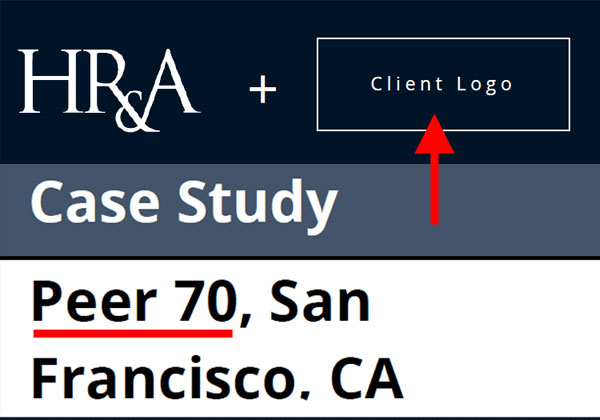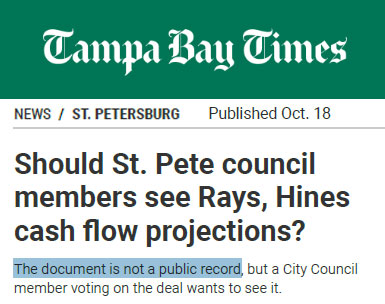“The document is not a public record,” the Tampa Bay Times claimed in its article about the cash flow projections that a firm working for the Rays provided to the City of St. Pete in early September. Yet when we made a public records request to the city, referencing that very Times article, we obtained the supposedly confidential document showing the projections.
“The projections are confidential and proprietary and are trade secrets under Florida law,” the Rays and their real estate partner Hines wrote in their proposal for a new stadium to the city. “The projections are exempt from disclosure under the Florida public records laws.” That, they claimed, is why their analysis was submitted separately from their proposal.
However, under Florida law the public agency in possession of a public record must make their own determination as to whether a public record is exempt from disclosure. Exemptions in Florida Statutes must be cited when withholding records from a requestor.
Also, any such agency decision is always subject to a challenge in court.
In other words, neither the Tampa Bay Rays, Hines or the firm that generated the projection, HR&A, get to decide which of the documents they submitted to the city are subject to disclosure under Florida’s public record law.
As for the financial projections themselves, the first 16 pages of the document we obtained are four nearly 4-page identical reports, all dated September 13 or 14. These reports arrive at different revenue claims, making it hard to know which of these four reports is the official projection.
The report appears to have been written by an HR&A “senior analyst” with a degree in Political Science and Art History who graduated college a mere 4.5 years ago. Based on that analyst’s LinkedIn profile, the analyst appears to have no relevant economics education or credentials and simply cites figures from another report that is not attached. “Figures for the ballpark’s economic output, tax revenue, and construction impacts are from a report conducted by Victus Advisors for Pinellas County in February, 2023,” the report says.

All four reports admit that the claimed “net new revenues” are “exclusive of displacement effects.” In plain English, this language means that their calculations don’t account for the revenues that would have been generated had something else been done with the site.
The confusing document is also error-ridden. It lacked a client logo on page 59 of the report, misspelled Pier 70 in San Francisco on page 54 as “Peer,” and falsely claimed on page 22 that Churchill Downs, the home of the Kentucky Derby, is located in Miami Gardens, Florida. The report also has footnote references in the wrong place and other errors that make understanding and interpretation of the report very difficult, if not impossible.
Furthermore, excluding the displacement effect means that in accordance with widely accepted economic terminology, these revenues should be labelled “gross new revenues,” not “net new revenues”.
We will follow up with HR&A to obtain more details about their report. We will also ask about the many mistakes in the report, and whether HR&A thought that writing the word “confidential” in their report twenty (20) times would actually make their document exempt from disclosure in response to our public records request. HR&A does not list an attorney among their 150+ employees.
Just three days ago, the Tampa Bay Times editorialized about the report we obtained, yet they never asked the city for a copy of it. Referencing their own article on the matter, the editorial said that “Council member Lisset Hanewicz rightly complained it made no sense that the administration was privy to the details but not the council, when the council had final city authority over approving the deal…But city officials said Tuesday they resolved the matter after convincing the Rays to share the data. Council members will have access to the projections, though they cannot share them publicly.“

Unlike the Tampa Bay Times, we thought the public should have access to those projections. After all, the Times editorial say that the proposed new stadium deal “will require a lot from the public — a lot of land, a lot of money and a lot of time.” If all this is required from the public, and it is indeed a lot, then the public must have access to all relevant information.
Journalists and reporters rely on the Florida public record statute in order to obtain information that public agencies otherwise may not want to share with them. In this case, the Tampa Bay Times accepted that organizations representing multi-billion dollars interests, namely the Rays and Hines, were allowed to illegally decide which public records to share with the public, and which ones not to share.
Was the real purpose of withholding the projections to hide their poor quality? Was the the real purpose of the Times editorial to give the Rays, Hines and council member Lisset Hanewicz a tongue bath?
As always, the Guardian reports and the readers decide. Please like our Facebook page to find out when we publish our articles.



